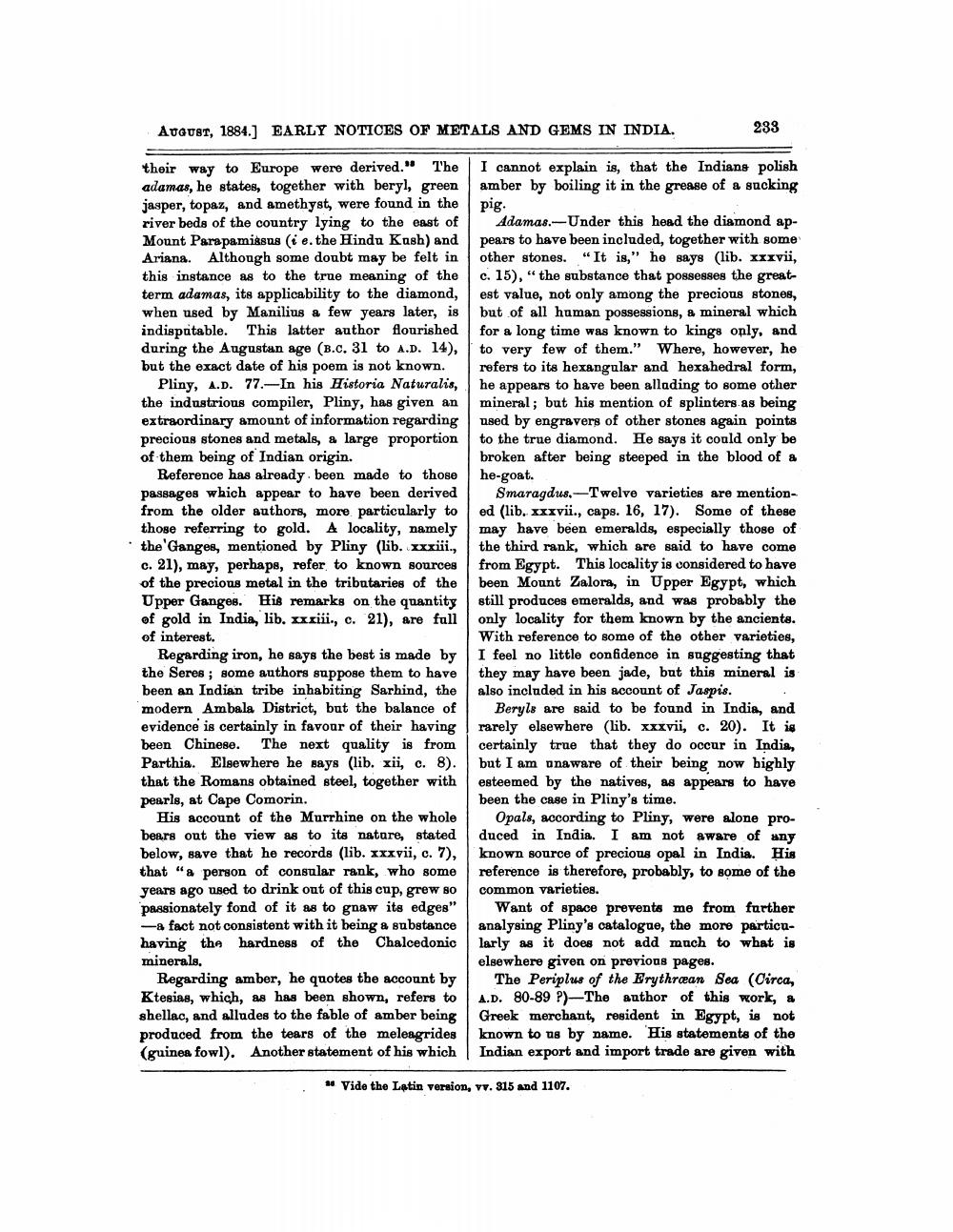________________
August, 1884.) EARLY NOTICES OF METALS AND GEMS IN INDIA.
233
their way to Europe were derived." The I cannot explain is, that the Indians polish adamas, he states, together with beryl, green amber by boiling it in the grease of a sucking jasper, topaz, and amethyst, were found in the river beds of the country lying to the east of Adamas.-Under this head the diamond apMount Parapamissus (i e. the Hindu Kush) and pears to have been included, together with some Ariana. Although some doubt may be felt in other stones. "It is," he says (lib. xxxvii, this instance as to the true meaning of the c. 15), “the substance that possesses the greatterm adamas, its applicability to the diamond, est value, not only among the precious stones, when used by Manilius a few years later, is | but of all human possessions, a mineral which indispatable. This latter author flourished for a long time was known to kinge oply, and during the Augustan age (B.C. 31 to A.D. 14), to very few of them." Where, however, he but the exact date of his poem is not known. I refers to its hexangular and hexahedral form,
Pliny, A.D. 77.-In his Historia Naturalis, he appears to have been alloding to some other the industrious compiler, Pliny, has given an mineral; but his mention of splinters as being extraordinary amount of information regarding nised by engravers of other stones again points precious stones and metals, a large proportion to the true diamond. He says it could only be of-them being of Indian origin.
broken after being steeped in the blood of a Reference has already been made to those he-goat. passages which appear to have been derived Smaragdus.-Twelve varieties are mentionfrom the older authors, more particularly to ed (lib. xxxvii., caps. 16, 17). Some of these those referring to gold. A locality, namely may have been emeralds, especially those of the Ganges, mentioned by Pliny (lib. xxxiii., the third rank, which are said to have come c. 21), may, perhaps, refer to known sources from Egypt. This locality is considered to have of the precious metal in the tributaries of the been Mount Zalora, in Upper Egypt, which Upper Ganges. His remarks on the quantity still produces emeralds, and was probably the of gold in India, lib. xxiii., c. 21), are full only locality for them known by the ancients. of interest.
With reference to some of the other varieties, Regarding iron, he says the best is made by I feel no little confidence in suggesting that the Seres ; some authors suppose them to have they may have been jade, but this mineral is been an Indian tribe inhabiting Sarhind, the also included in his account of Jaspis. modern Ambala District, but the balance of Beryls are said to be found in India, and evidence is certainly in favour of their having rarely elsewhere (lib. xxxvii, c. 20). It is been Chinese. The next quality is from certainly true that they do occur in India, Parthia. Elsewhere he says (lib. xii, c. 8). but I am unaware of their being now highly that the Romans obtained steel, together with esteemed by the natives, as appears to have pearls, at Cape Comorin.
been the case in Pliny's time. His account of the Murrhine on the whole Opals, according to Pliny, were alone probears out the view as to its nature, stated duced in India. I am not aware of any below, save that he records (lib. xxxvii, c. 7), known source of precious opal in India. His that "a person of consular rank, who some reference is therefore, probably, to some of the years ago used to drink out of this cup, grew 80 common varieties. passionately fond of it as to gnaw its edges" Want of space prevents me from further -a fact not consistent with it being a substance analysing Pliny's catalogue, the more particuhaving the hardness of the Chalcedonic larly as it does not add much to what is minerals,
elsewhere given on previous pages. Regarding amber, he quotes the account by The Periplus of the Erythræan Sea (Circa, Ktesias, which, as has been shown, refers to A.D. 80-89 ?)-The author of this work, a shellac, and alludes to the fable of amber being Greek merchant, resident in Egypt, is not produced from the tears of the meleagrides known to us by name. His statements of the (guinea fowl). Another statement of his which | Indian export and import trade are given with
# Vide the Latin version, vv. 315 and 1107.




